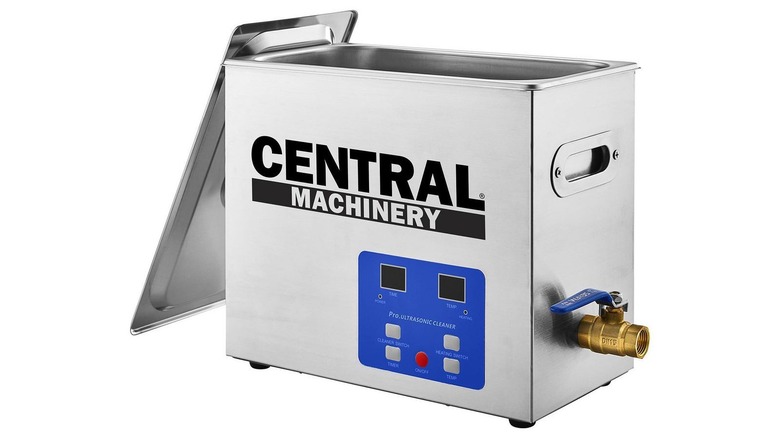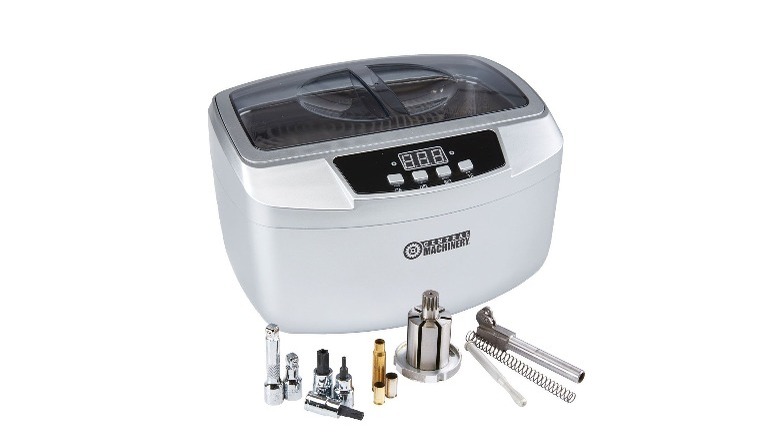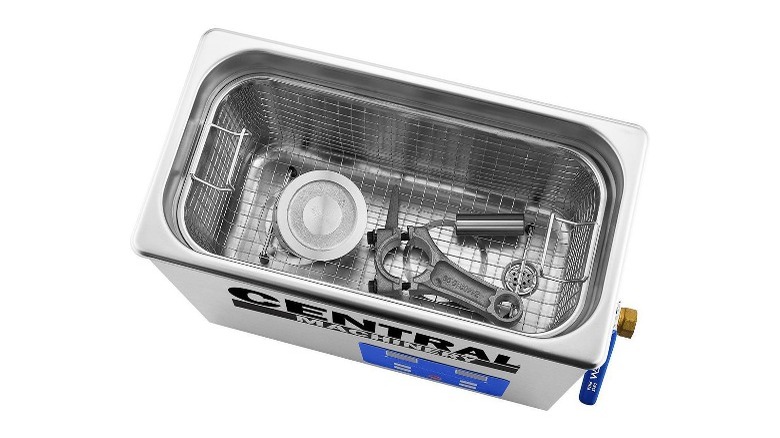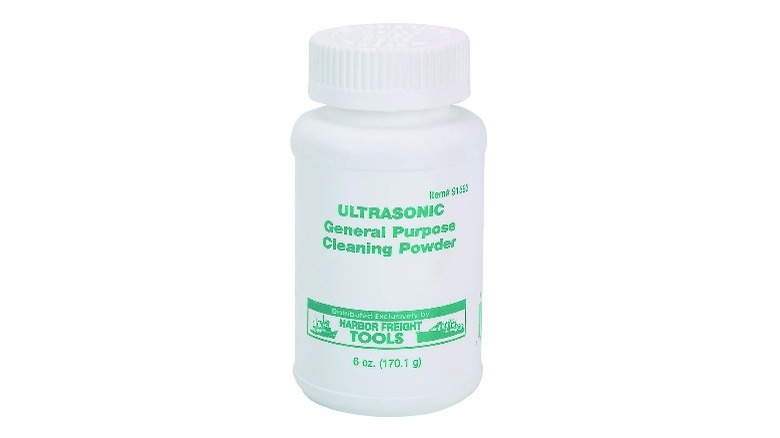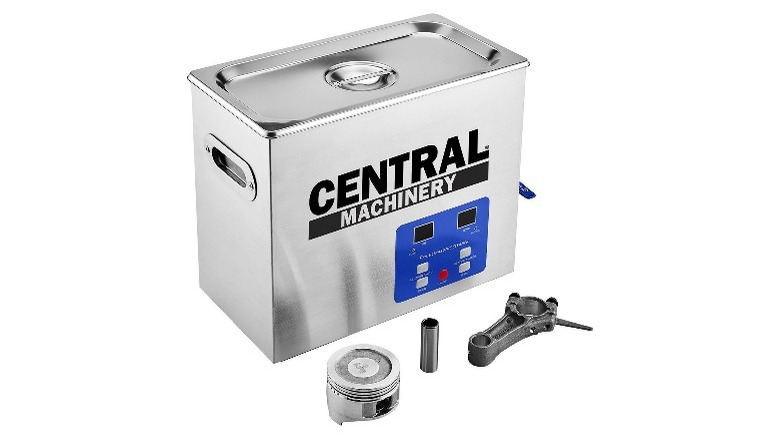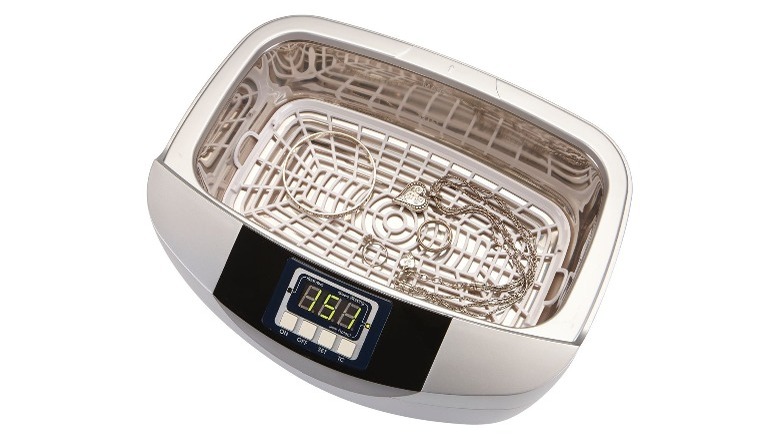Everything You Need To Know About Harbor Freight Ultrasonic Cleaners Before You Buy
We may receive a commission on purchases made from links.
Have you ever tried cleaning burnt grease off a small washer? It's surprisingly difficult. There is so little surface area to grip that it's all too easy for the little devils to slip free and roll under a work desk or cabinet, never to be seen again. Small parts like these can be a hassle to clean at the best of times, and an infuriatingly tedious task at the worst. Especially since trying to wash them clean in a normal sink is a one-way ticket to watching the parts vanish down the drain. Fortunately, there are a few appliances designed specifically for this purpose.
Harbor Freight has a lot of different tools that every home mechanic will want, including two different sizes of ultrasonic cleaners. These are both made by Central Machinery–the same company that makes a cement mixer, blast cabinet, and band saw mill which are also sold in the store. They are specially designed for washing the grime away from everything from hardware, fasteners, and small parts, to jewelry and other, more delicate items. But before rushing out to buy your own, you might be interested in learning how they work, what kind of cleaning agents they use, which of the two sizes you need, how much each of them costs, and whether they have any other features you might need. Here's everything you need to know.
How do ultrasonic cleaners work?
So the first thing you probably want to know is how these part cleaners actually work. Ultrasonic sounds very high-tech, but the physics behind it is actually pretty straightforward. Each of the cleaners has a reservoir that you would fill with water mixed with a specialized cleaning solution. That isn't all though. "The cleaner uses 40 kHz high-frequency sound waves to clean stubborn dirt from surfaces, threads, and internal parts," the product description states. "It is gentle enough to clean delicate items such as carburetors, fuel injectors, hardware, jewelry, small metal parts, and eyeglasses."
See, sound ultimately boils down to frequencies of vibration, and higher frequencies vibrate at a faster and more compact wavelength than lower ones. Soundwaves also carry more strongly in liquids than they do in gasses. So by introducing an ultra-high soundwave to the solution inside the Ultrasonic Parts Cleaner, it vibrates at an incredibly tight and rapid pace, creating motion against the surface of the item being cleaned. So the solution itself is gently scrubbing away at the surface. This is why these cleaners are particularly nice for cleaning objects that have narrow gaps and openings that are difficult to scrub out by hand.
How well do ultrasonic cleaners work?
Knowing the science behind them is all well and good, but you might also be interested in learning how good these ultrasonic cleaners are at actually removing heavy gunk. Automotive components can be pretty gnarly when you yank them from a well-used vehicle, so you need to know that the cleaner will be able to do its job.
Fortunately, it seems to be quite effective. Both models have a heated water function to help loosen up grime, even if it's really caked-on. The 2.5 L model has five different preset cycles for different levels of cleaning. The 6 L model doesn't advertise any specific cleaning modes, but it does promise to clean parts in just 30 minutes.
You don't have to take Harbor Freight's word for it, though. YouTuber 1D10CRACY made a video showcasing the 6 Liter Ultrasonic Cleaner in action. He put a tractor hinge that was caked in grease, dirt, and other substances. The machine striped the part down to the bare metal in just ten minutes. Removing everything except for the paint and rust. So you might have to resort to other methods to restore rusty old tools, but the machine seems good for removing just about everything else.
What sort of cleaning agent do they use?
So what exactly is this cleaning solution that you're going to be putting in the ultrasonic cleaner? You probably want to know a little bit more about it before you commit to buying the machine that needs it to run.
Well, there are actually a few different kinds available from different brands. Harbor Freight itself sells a 6oz. bottle of general-purpose cleaning powder that's specifically designed for use in ultrasonic cleaners. It costs $8.99 and is made "to clean and gently polish jewelry, utensils, tools and small parts." There is a warning not to use it with aluminum or magnesium alloys, but it has fairly good reviews. It has 4.3 stars on the Harbor Freight website, and most users were happy with its performance, though there were a few that claimed it struggles with carburetors.
There are other chemicals available from different retailers. Northwest Enterprises sells a liquid cleaning solution on Amazon that is specifically designed for carburetors, fuel injectors, and other auto parts. It's a bit more expensive, however, with a 32 Oz. bottle going for $25.99 and a 1gal bottle going for $45.99. Another brand called Calyptus sells an 8 Fl. Oz. bottle that is designed for jewelry and glasses.
You don't necessarily have to use a specific cleaner — it's not uncommon for people to use everything from vinegar to Simple Green in ultrasonic cleaners, which can have varying degrees of success depending on what you are trying to clean.
What size do you need?
While both of the ultrasonic cleaners sold at Harbor Freight are made by Central Machinery, one is significantly larger than the other. The smaller size is 2.5 L and the larger is 6 L.
The 2.5 Liter Ultrasonic Parts Cleaner is 6 ⅞" tall, 8 ¾" wide, and 11 ¼" in length. Keep in mind that this is the size of the entire appliance, including the housing and controls. Harbor Freight doesn't specify the dimensions of the actual washing basket, but it is rectangular and looks to be about the size of a small loaf of bread. This seems ideal for fasteners, jewelry, small metal parts, and the smallest of hand tools.
As the name suggests, the 6 Liter Ultrasonic Parts Cleaner is more than double the size. Harbor Freight doesn't list the dimensions for this one at all, but the house and the basket each look to be about the same size and shape that you would expect to see in a home deep fryer. It can handle much larger parts, like heavy-duty hinges, carburetors, fuel injectors, gears, bearings, and slightly larger hand tools, such as medium-sized screwdrivers and wrenches.
How much do they cost?
Now that you know more about what these ultrasonic cleaners are, you probably want to know how much each of them will run you. Harbor Freight has a reputation for selling its products at steep discounts compared to its competitors. That's certainly true for the smaller model, but the larger one has some steep competition.
The 2.5 L model currently goes for $89.99. That's pretty cheap when compared to models like the Lyman Turbo Sonic 2500 which is a similar size and MSRPs at $184.95. It's even a bit cheaper than Amazon's top choice, the H&B Luxuries Industrial Grade Ultrasonic Cleaner, which sells for $95.98.
The 6 L model goes for $179.99. That's a hefty step up in price. Amazon's top choice for a 6L Ultrasonic cleaner is the one made by Vevor. This appears to be nearly identical to the Central Machinery model, but it can be had for just $129.99. This makes it hard to justify the standard retail price at Harbor Freight, but it still might be worthwhile if you can get it on one of the store's infamous seasonal super sales.
